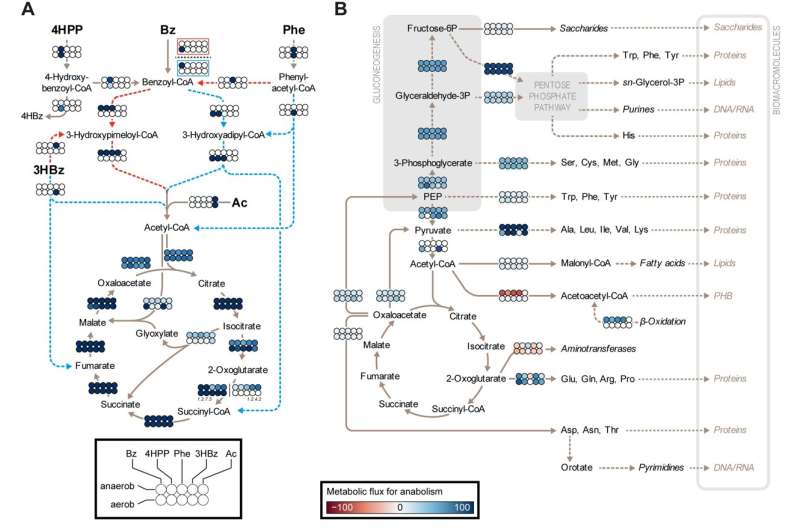Researchers decipher the inner workings of A. aromaticum bacterium

The metabolism of a key environmental microbe has been elucidated in detail by a team led by researchers at the University of Oldenburg. This holistic understanding allows reliable prediction of the growth of the microbes. The species specializes in the degradation of long-lived organic substances and therefore plays an important role in biological soil remediation.
A team led by University of Oldenburg microbiologist Prof. Dr. Ralf Rabus and his Ph.D. student Patrick Becker has gained deep insights into the cellular mechanisms of a common environmental bacterium. The researchers examined the entire metabolic network of the bacterial strain Aromatoleum aromaticum EbN1T and used the results to develop a metabolic model with which they can predict the growth of these microbes under diverse environmental conditions.
As the researchers report in mSystems, their analysis revealed certain unexpected mechanisms that apparently enable these bacteria to adapt to rapidly changing environmental conditions. The results of the study are important for ecosystems research, a field where the Aromatoleum strain, as a representative of a key group of environmental bacteria, can serve as a model organism, and could also be of interest in the remediation of contaminated sites and for biotechnological applications.
The studied bacterial strain specializes in using organic substances that are difficult to break down and is generally found in soil and in aquatic sediments. The microbes thrive in a variety of conditions including oxygen, low-oxygen and oxygen-free layers, and are also extremely versatile in terms of nutrient intake.
They metabolize more than 40 different organic compounds including highly stable, naturally occurring substances such as components of lignin, the main structural material found in wood, and long-lived pollutants and components of petroleum.
In particular, substances with a benzene ring composed of six carbon atoms, known as aromatic compounds, can be biodegraded by these microbes—with or without the aid of oxygen. Due to these abilities, Aromatoleum plays an important environmental role in the complete degradation of organic compounds in soil and sediments to carbon dioxide—a process that is also useful in biological soil remediation.
The aim of the current study was to gain a holistic understanding of the functioning of this unicellular organism. To this end, the researchers cultivated the microbes under both oxic and anoxic conditions—i.e. with and without oxygen—using five different nutrient substrates. For each of these ten different growth conditions, they grew 25 cultures and then examined the various samples using molecular biology methods (technical term: multi-omics), which enable simultaneous analysis of all the transcribed genes in a cell, all the proteins produced and all its metabolic products.
“With this systems biology approach, you gain a deep understanding of all the inner workings of an organism,” explains Rabus, who heads the General and Molecular Microbiology research group at the University of Oldenburg’s Institute for Chemistry and Biology of the Marine Environment (ICBM). “You break down the bacterium into its individual components and then you can put them back together—in a model that predicts how fast a culture will grow and how much biomass it will produce.”
Through their meticulous work, the researchers obtained a comprehensive understanding of the metabolic reactions of this bacterial strain. They found that around 200 genes are involved in the degradation processes and determined which enzymes break down the substances added as nutrients and via which intermediates the various nutrients are decomposed. The scientists incorporated their findings about the metabolic network into a growth model, and demonstrated that the model predictions largely corresponded to the measured data.
“We can now describe the organism with a level of precision that has so far only been possible with very few other bacteria,” says Rabus. This holistic view of the bacteria’s cellular inner workings forms the basis for a better understanding of the interactions between the analyzed strain (and related bacteria) and their biotic and abiotic environment, he adds, and can also help scientists to better predict the activity of these unicellular organisms in polluted soils, and thus, for example, determine the optimal conditions for the remediation of a contaminated site.
By combining different methods, the team was able to uncover unexpected mechanisms in the metabolism of these bacteria. Much to the researchers’ surprise, it emerged that the microbe produces several enzymes it cannot use under the given growth conditions—which at first glance would seem to be a superfluous expenditure of energy.
“Usually the bacterial cells detect whether oxygen is present in their environment, and then, via specific mechanisms, activate only the nutrient-specific metabolic pathway with the corresponding enzymes,” Rabus explains. But with some substrates, the microbe produced all the enzymes for aerobic and anaerobic degradation pathways regardless of oxygen levels—even though some of these enzymes were entirely superfluous.
Rabus suspects that this apparent waste is in fact a strategy for surviving in an unstable environment. “Even if oxygen levels suddenly fluctuate—which is often the case in natural environments—Aromatoleum remains flexible and can utilize this nutrient and produce energy as required,” the microbiologist explains, adding that so far, no other bacteria are known to use such a mechanism.
More information:
Patrick Becker et al, Systems Biology of Aromatic Compound Catabolism in Facultative Anaerobic Aromatoleum aromaticum EbN1 T, mSystems (2022). DOI: 10.1128/msystems.00685-22
Citation:
Researchers decipher the inner workings of A. aromaticum bacterium (2023, January 26)
retrieved 27 January 2023
from https://phys.org/news/2023-01-decipher-aromaticum-bacterium.html
This document is subject to copyright. Apart from any fair dealing for the purpose of private study or research, no
part may be reproduced without the written permission. The content is provided for information purposes only.
For all the latest Science News Click Here
For the latest news and updates, follow us on Google News.

